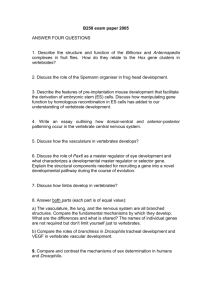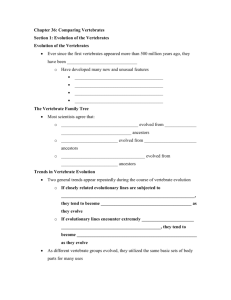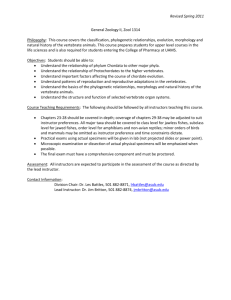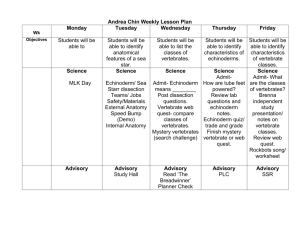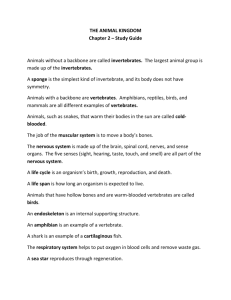Vertebrates
advertisement
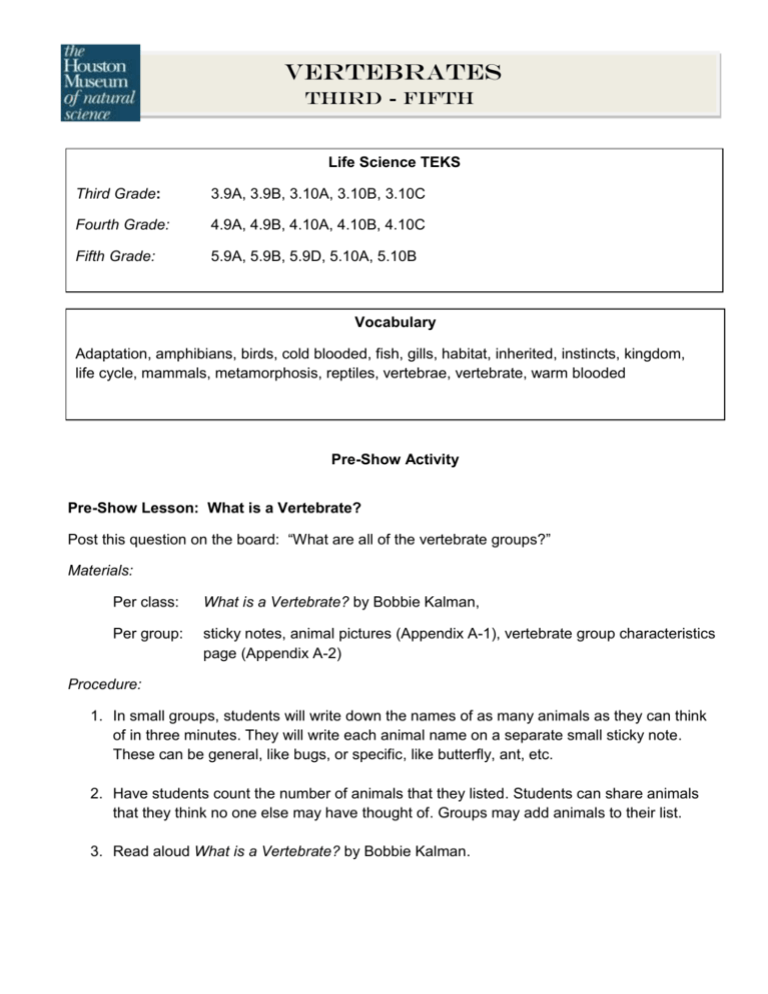
Vertebrates Third - Fifth Life Science TEKS Third Grade: 3.9A, 3.9B, 3.10A, 3.10B, 3.10C Fourth Grade: 4.9A, 4.9B, 4.10A, 4.10B, 4.10C Fifth Grade: 5.9A, 5.9B, 5.9D, 5.10A, 5.10B Vocabulary Adaptation, amphibians, birds, cold blooded, fish, gills, habitat, inherited, instincts, kingdom, life cycle, mammals, metamorphosis, reptiles, vertebrae, vertebrate, warm blooded Pre-Show Activity Pre-Show Lesson: What is a Vertebrate? Post this question on the board: “What are all of the vertebrate groups?” Materials: Per class: What is a Vertebrate? by Bobbie Kalman, Per group: sticky notes, animal pictures (Appendix A-1), vertebrate group characteristics page (Appendix A-2) Procedure: 1. In small groups, students will write down the names of as many animals as they can think of in three minutes. They will write each animal name on a separate small sticky note. These can be general, like bugs, or specific, like butterfly, ant, etc. 2. Have students count the number of animals that they listed. Students can share animals that they think no one else may have thought of. Groups may add animals to their list. 3. Read aloud What is a Vertebrate? by Bobbie Kalman. Lead students to understand why animals are put in the vertebrate group. They should record the definition of a vertebrate in their science notebook. Vertebrates are animals that have a backbone. Tell students to feel their backbone. They are in the vertebrate group. 4. Students will go back and organize their sticky notes into two groups: vertebrates and nonvertebrates (invertebrates). If a group is uncertain, they can raise their hand for assistance. 5. In groups, students will now try to separate their vertebrate sticky notes into smaller groups. They should put a title on each group. 6. Introduce the five vertebrate groups that scientists created. Give students the pictures of the vertebrates in Appendix A-1. Students will write the titles “Mammals”, “Amphibians”, “Reptiles”, and “Birds” on a large piece of paper or using a dry erase marker on their desks. Students will sort pictures into the vertebrate groups they belong to (see Appendix A-1). 7. Students will come up with a list of characteristics that they used to decide where to place each animal. They should list these characteristics under each group name in their science notebook. For younger students, you may want to give them the list of characteristics first and then have them do the sort (see Appendix A-2). 8. Students will compare their description with the actual scientific reason for each group. They should be able to find this information in their science notebook, or they can use the chart in Appendix A-2. Using a different color pen or colored pencil, they will make corrections to the characteristics list that they made in their science notebook. Post-Show Enrichment Activities Activity One: Vertebrate Guessing Game Procedure: 1. For the game, a student will come up to the front of the room and think of an animal that was discussed in the show. 2. The student will then give clues about the animal. For example: “I am endothermic”, “I have thin, moist skin”, etc. 3. Students should be able to guess the vertebrate group first. 4. After they guess the group, the clues will need to get more specific. “I have leaping legs”. Make sure to model the game first. To make it easier, you can go to the National Geographic website for kids and print off some of their animal trading cards or just put one up on a laptop for the student who is at the front of the class to see. http://kids.nationalgeographic.com/kids/animals/creaturefeature/ Activity Two: Vertebrae Model Materials: Per child: chenille stem (pipe cleaner), wagon-wheel pasta, uncooked*candy gelatin rings (like Life-Saver gummies) Procedure: 1. Bend one end of the chenille stem so that the pasta cannot fall through. Put six pieces of wagon-wheel pasta through the stem down toward the bent end. Bend the stem above the pasta to hold the pasta in place. 2. Bend and twist the stem. What do you see and hear? 3. Take all the pasta off the stem except one. Place a gelatin ring on the pasta. Alternate between pasta and gelatin ring. 4. Add pasta and rings until the stem is almost full. Bend the stem above the pasta and rings to hold them in place. HMNS 3-5 Vertebrates Page 3 5. Bend and twist the stem. What do you hear? 6. Draw pictures of the model backbones you made. Compare your model with a picture of a real backbone. This can be found in the science text book, reference book, or online. What does each part of your model stand for? What is the purpose of each part? What parts are missing from the model? How could you improve this model? Teacher Information: Vertebrae: The spine is a column of small bones, or vertebrae, that support the entire upper body. The column is grouped into three sections of vertebrae: Cervical (C) vertebrae are the seven spinal bones that support the neck. Thoracic (T) vertebrae are the 12 spinal bones that connect to the rib cage. Lumbar (L) vertebrae are the five lowest and largest bones of the spinal column. Most of the body's weight and stress falls on the lumbar vertebrae. Each vertebra can be designated by using a letter and number; the letter reflects the region (C=cervical, T=thoracic, and L=lumbar), and the number signifies its location within that region. For example, C4 is the fourth bone down in the cervical region, and T8 is the eighth thoracic vertebra. Below the lumbar region is the sacrum, a shield-shaped bony structure that connects with the pelvis at the sacroiliac joints. At the end of the sacrum are two to four tiny, partially fused vertebrae known as the coccyx or "tail bone." The Disks. Vertebrae in the spinal column are separated from each other by small cushions of cartilage known as intervertebral disks. Inside each disk is a jelly-like substance called the nucleus pulposus, which is surrounded by a tough, fibrous ring called the annulus fibrosis. The disk is 80% water. This structure makes the disk both elastic and strong. The disks have no blood supply of their own, relying instead on nearby blood vessels to keep them nourished. Spinal cord: A column of nerve tissue that runs from the base of the skull down the back. It is surrounded by three protective membranes, and is enclosed within the vertebrae (back bones). The spinal cord and the brain make up the central nervous system, and spinal cord nerves carry most messages between the brain and the rest of the body. Source: University of Maryland Medical Center HMNS 3-5 Vertebrates Page 4 Activity Three: Inherited versus Learned Behavior Materials: instinct video Procedure: 1. Students will make a T-chart in their notebooks with the titles “Instincts/Inherited Behaviors” and “Learned Behaviors”. 2. Show a video related to instincts and learned behaviors. They will complete the chart in their science notebook. If you cannot find a video, you can give each group a separate animal book to use. Examples: Fierce Lion (Animal Instincts) by Tom Jackson Curious Dolphin (Animal Instincts) by Tom Jackson Deadly Cobra (Animal Instincts) by Tom Jackson 3. Students will take the behaviors on their charts and, as a group, write as many different behaviors down as they can, each on a separate index card. 4. Students will exchange cards with another group and sort them as inherited or learned. 5. Next, they can re-sort them by the need that is being met by each behavior: food, water, oxygen, shelter or reproduction. 6. Mix all of the cards in the class together and give each group about the same number of cards. Groups will now sort the cards by vertebrate groups. 7. Students can complete the worksheet in Appendix A-3. Activity Four: Getting to Know Vertebrates Materials: chart (Appendix A-4), reference books or internet Procedure: 1. Students will complete the chart in Appendix A-4. 2. For younger students, you may want to cut the chart into strips and give them each one or two strips to complete instead of the whole chart. Students will use animal books, their science textbook and the Internet as resources. Teacher Notes: You will need to model how to complete a strip before students begin. If you have not covered adaptations or food chains, you may need to explain these when you model the activity for the students. By third grade though, they should be familiar with these words. In the first column (body characteristics) students should think about the characteristics of the vertebrate group (see Appendix A-4). HMNS 3-5 Vertebrates Page 5 Appendix A-1 Cockatoo fish Yellow-rumped thornbill Common death adder Cow fish Ablepharus pannonicus Bolivian chinchilla rat Northern goshawk Cheetah Bishop ray California sea lions Pygmy right whale HMNS 3-5 Vertebrates Orange leaf nose bat Page 6 Gharial Florida leopard frog Southeast Asian box turtle Siren Ambystoma Ostrich All photos are taken from: http://animaldiversity.ummz.umich.edu/site/index.html HMNS 3-5 Vertebrates Page 7 A-2 Copycat Page from National Wildlife Federation, Nature Scope - Amazing Animals, Part I, 1988 HMNS 3-5 Vertebrates Page 8 A-3 Name _______________________ Date _________ Learned Behavior or Instinct??? Type of vertebrate Instinct or Learned Behavior What need is being met (food, shelter, water, oxygen, reproduction) 1. Proboscis monkey mothers must teach their young which leaves are safe to eat. 2. A dolphin catches a ball and balances it on its nose. 3. Bears can adapt to harsh winters by hibernating. 4. A young Chinese boy begins to speak in Chinese. 5. Humpback whales migrate from their nurseries off the coast of Hawaii to feed in the krill-rich waters off of Alaska 6. Newborn babies cry when they want something. 7. If an animal runs from a lion, the lion will chase it. 8. Birds build their nests. 9. Young lions learn from their mothers how to be better hunters. 10. Adult penguins sit on their eggs to keep them warm until they hatch. List 3 other learned behaviors and 3 instincts not mentioned above. HMNS 3-5 Vertebrates Page 9 A-4 Name____________________________ Date ________________ Vertebrates External Characteristics Habitat & Food chain Life Cycle 2 Adaptations Draw a food chain Adaptations Life Cycle Describe Habitat Reptile: Amphibian: HMNS 3-5 Vertebrates Page 10 Draw a food chain Adaptations Life Cycle Describe Habitat Draw a food chain Adaptations Life Cycle Describe Habitat Draw a food chain Adaptations Life Cycle Describe Habitat Fish: Bird: Mammal: HMNS 3-5 Vertebrates Page 11


